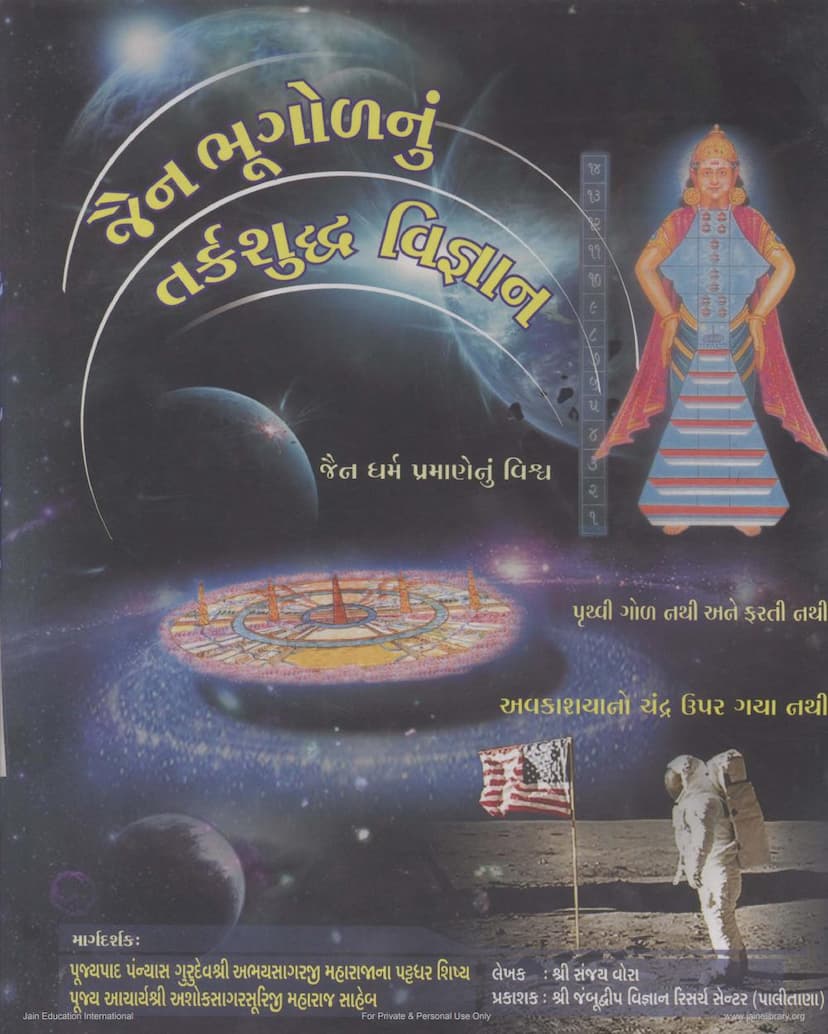Jain Bhugol Nu Tarkshuddha Vigyan
Added to library: September 1, 2025

Summary
Summary of "Jain Bhugol nu Tarkshuddha Vigyan"
"Jain Bhugol nu Tarkshuddha Vigyan" (Jain Geography: Rational Science), authored by Sanjay Vora and published by Shri Jambudweep Vigyan Research Centre, presents a detailed exposition of Jain cosmology and geography, challenging prevailing modern scientific notions about the Earth and the universe. The book, guided by Acharya Ashok Sagarsuri Maharaj Saheb, disciple of Pujyapad Punyasagarji Maharaj, aims to scientifically and logically prove the veracity of Jain scriptures regarding the structure of the universe.
The central thesis of the book is that the Earth is not a spinning sphere as conventionally believed, but rather a flat, stationary disc. It argues that modern scientific explanations for phenomena like day-night cycles, seasons, eclipses, and tides are flawed and that the Jain understanding, based on empirical observations and rigorous logic, offers a more accurate and consistent model of the universe.
Key arguments and points made in the book include:
- Rejection of the Spherical Earth Model: The book asserts that modern science lacks concrete proof for a spherical and rotating Earth. It highlights experimental evidence and observations that allegedly demonstrate the Earth's flatness and stillness. The author critiques commonly cited proofs for a spherical Earth, such as the appearance of ships on the horizon, arguing they can be explained by principles of perspective and atmospheric refraction.
- Critique of Modern Astronomy and Physics: The text deconstructs modern scientific theories like gravity, celestial mechanics, and space travel, particularly the Apollo moon missions. It suggests that these are elaborate hoaxes or misinterpretations of reality, designed to mislead the public and undermine religious texts, including Jain scriptures. The book casts doubt on the possibility of space travel and lunar missions, citing alleged inconsistencies and lack of verifiable evidence.
- Jain Cosmological Model: The book extensively describes the Jain cosmological framework, emphasizing the centrality of Mount Meru and the Jambudweep continent. It details the layout of Jambudweep, including its seven regions (Kshetras), the mountain ranges separating them (Varshadhar Parvats), and the surrounding oceans. The text elaborates on the concept of different realms within the universe (Loka), including heavenly and hellish realms, and the cyclical nature of time (Avasarpini and Utsarpini Kal).
- Reinterpretation of Natural Phenomena: Phenomena like day and night, seasons, and the movement of celestial bodies are explained within the Jain framework as the orbital path of the Sun around Mount Meru, rather than the Earth's rotation or revolution. The book presents alternative explanations for eclipses and tides that do not rely on modern physics.
- Historical Perspective: The book traces the history of cosmological beliefs, suggesting that ancient civilizations and religious texts (including those of Christianity and Islam) predominantly viewed the Earth as flat and stationary. It argues that the shift to a heliocentric, spherical Earth model was driven by figures like Copernicus and Galileo without sufficient empirical evidence and was propagated through the modern education system, particularly influenced by colonial powers.
- Critique of Scientific Authority: The author questions the absolute authority of modern scientists and institutions like NASA, suggesting their findings are influenced by political agendas and financial interests. The book highlights historical instances where scientific understanding has evolved or been overturned, implying that current models may also be incorrect.
- Call for Re-evaluation: The book encourages readers to critically examine established scientific beliefs, use their own reasoning and observation, and consider the Jain scriptures as a source of verifiable scientific truth about the universe.
The book is presented as a work of "rational science" within the Jain tradition, aiming to reconcile ancient wisdom with scientific inquiry and provide a "true understanding" of geography and cosmology. It serves as a defense of Jain philosophy against what the author perceives as the misguidance of modern, materialistic science.